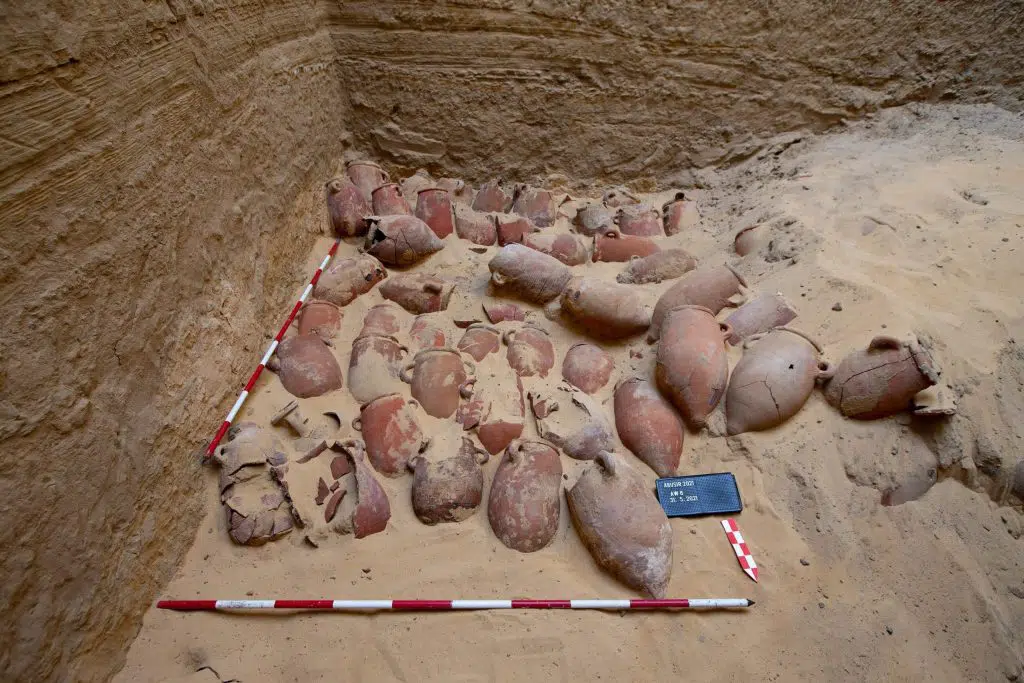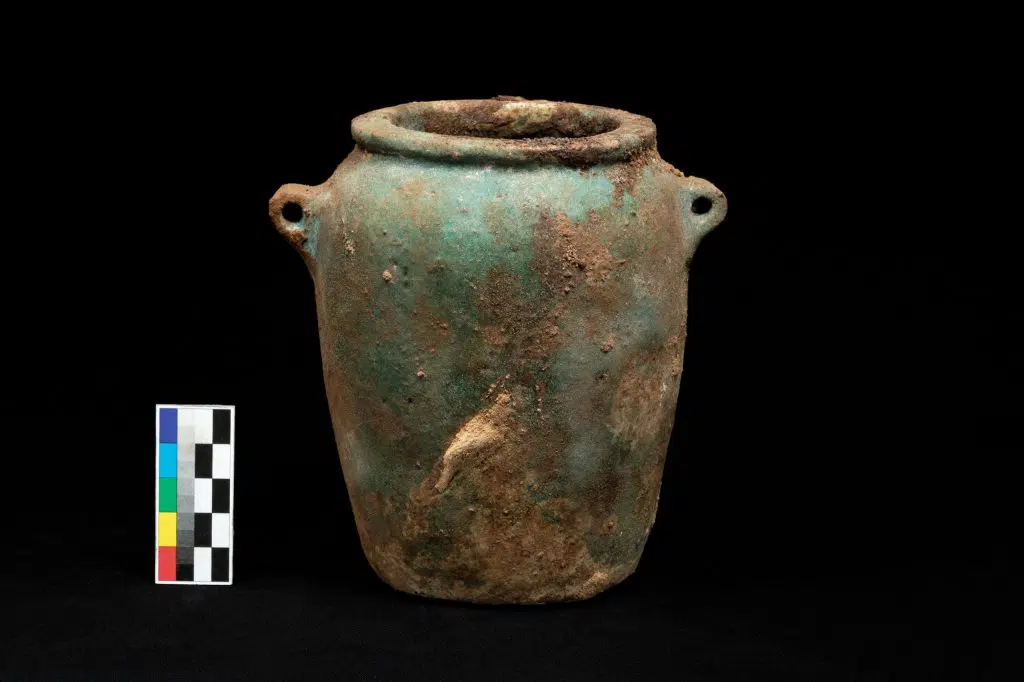
The largest embalming vessel cache ever found in Egypt was unearthed at Abusir, north of Giza, the location of the Great Pyramids.
The amazing discovery, including vessels with the names of the dead who were to have been embalmed, was found in 2022 during what researchers called “routine” excavations 30 km (19 miles) north of the Giza Plateau, the site of the Great Pyramids.
Undertaken by archaeologists from the Czech Institute of Egyptology at the Charles University in Prague, the dig excavated a shaft which contained priceless vessels depicting people and animals as well as one vessel that was in the shape of the hieroglyphic character for “heart.”
“House of Osiris” home to largest embalming vessel cache ever discovered
As reported by Ahram Online, Abusir means “House of Osiris,” the ancient Egyptian god of the dead and resurrection. Abusir became a burial place for Egyptian royalty during the reign of king Userkaf, the founder of the Fifth Dynasty, who built a remarkable temple there.
Osiris is the Egyptian equivalent of the Greek god Dionysus. Other syncretic Greco-Egyptian deities were also worshiped three centuries later, when the Ptolemies, the descendants of the generals of Alexander the Great, ruled Egypt, including Serapis and Hermanubis.
Dionysus-Osiris was particularly popular in Ptolemaic Egypt, however; the Ptolemies claimed descent from Dionysus. After they were made pharaohs, they had claim to the lineage of Osiris.

Wahibre-mery-Neith, “son of the Lady Irturu,” owned some of the stunning funerary vessels
Some of Userkaf’s successors also built their own mortuaries and temples dedicated to the sun at Abusir. The last such temple was built by King Menkauhor at the end of the Fifth Dynasty, the Czech Institute of Egyptology reports in its announcement of the find.
The institute has been exploring a 26th-Dynasty cemetery at Abusir for more than three decades. The twenty-sixth dynasty of Egypt was the last native regime to rule Egypt before the Persian conquest in 525 BC, although others followed after that.
The era of this dynasty, which lasted from 664–525 BC, is also called the Saite Period, after the city of Sais, where its pharaohs had their capital; it marks the beginning of the Late Period of ancient Egypt.

during an embalming ceremony is part of the cache of embalming vessels found at Abusir, Egypt. Credit: Charles University, Prague/Egyptian Ministry of Tourism and Antiquities
During recent excavation work at Abusir, a group of large shaft tombs in the western corner of the necropolis were found to contain the cache of remarkable funerary vessels.
“With 370 large pottery storage jars and a number of smaller artifacts, it is probably the largest complex and undisturbed find of its kind originating from ancient Egypt,” states Mohamed Megahed, the deputy head of the archaeological mission.
Megahed added that most of the vessels contained remnants or residues from materials and utensils that had been used during the mummification process. The shaft in which they were found was more than 14 meters (45 feet) deep. It is next to another tantalizing burial structure that has not yet been excavated.

Another burial structure nearby has still not been excavated
As reported in Arkeonews, the pottery and stone vessels were nestled together in fourteen clusters at depths from four to twelve meters (39 feet) below ground, arranged along the sides of the shaft in a spiral pattern. Each group of vessels comprised between seven to 52 vases.
Four inscribed canopic jars made of limestone were found in the highest layer of the shaft; all of these were empty and had not been used, according to the archaeologists. According to the texts inscribed on them, the jars belonged to a man named Wahibre-Mery-Neith, son of the Lady Irturu.
“The 2021 season was part of a long-term project aiming at excavating and interpreting monuments dating to a period when ancient Egyptian society was looking for new means to maintain its unique identity, then challenged by Greek, Persian and Nubian armies,” states Miroslav Bárta, the director of the archaeological mission.
Admiral Udjahorresnet and General Menekhibnekau likely owned the tombs
“The shaft tombs of Abusir, built in a similar fashion to the famous burial of the Pharaoh Djoser, the founder of the Old Kingdom, played a major role in the unique way of cultural expression used by the Egyptian elites of the period,” he added.
Unfortunately, ther is no way to know exactly who this Wahibre-Mery-Neith was, since there were so many men with that name at the time. “Although a number of dignitaries of this name are known from this period, none of them can be identified as the owner of the canopic jars, as different mothers are attested for all of them,” Bárta explains.
Ladislav Bareš, another leading expert on the period, adds that we may be able to know the owners of the entire funerary complex, however. He states “Judging from the size of the embalming deposit and from the dimensions and arrangement of the nearby tomb, the owner of the tomb and of the deposit must have belonged to the highest dignitaries of his time, together with his closest neighbors in the cemetery — the admiral Udjahorresnet and general Menekhibnekau.”
The archaeologists say that there will be further excavations, which will focus on the burial structure that they know is at the bottom of a huge central shaft in the complex. Meanwhile, analyses of the vessels and their contents using modern scientific methods will continue.
See all the latest news from Greece and the world at Greekreporter.com. Contact our newsroom to report an update or send your story, photos and videos. Follow GR on Google News and subscribe here to our daily email!



